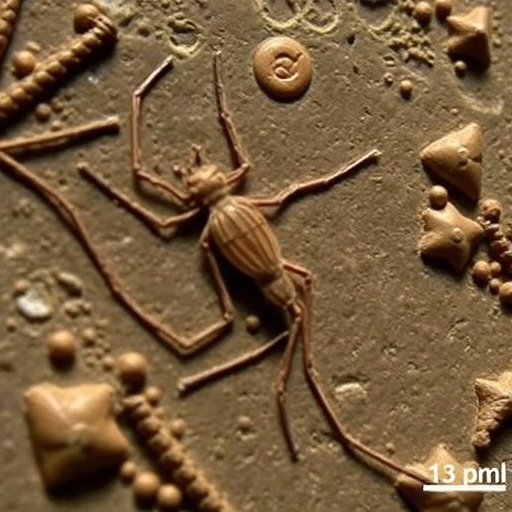A groundbreaking discovery in the field of paleoentomology has emerged from researchers at Ludwig-Maximilians-Universität München (LMU), shedding unprecedented light on the evolutionary history of mosquitoes. Unearthed from a 99-million-year-old piece of amber originating from the Kachin region in Myanmar, this remarkable fossil represents the oldest known mosquito larva ever found, pushing back the temporal boundaries of mosquito ontogeny well into the Cretaceous period. Unlike previously known mosquito fossils from this era, exclusively adult specimens, this immature form offers a rare glimpse into the developmental biology of ancient mosquitoes and their ecological niches during the Mesozoic Era.
What makes this discovery truly exceptional is the discovery of a new species and genus, aptly named Cretosabethes primaevus. The specimen is exquisitely preserved, allowing for detailed morphological characterization which reveals striking similarities to modern mosquito larvae. This contrasts sharply with other Mesozoic mosquito fossils, which exhibit markedly divergent morphologies and belong to an extinct group known as Burmaculicinae. The newfound larva is affiliated with the Sabethini tribe, a lineage represented by extant species today, making it a vital link in understanding the continuity of mosquito lineages over nearly 100 million years.
The implications of this discovery extend far beyond mere taxonomy. Morphological assessments of this larva suggest that key developmental traits and ecological habits have remained remarkably conserved since the Jurassic period. This challenges prior assumptions that the early evolutionary history of mosquitoes involved significant morphological experimentation and diversification. By preserving the larva in amber within a microhabitat such as small water accumulations in tree hollows or among epiphytic plants, the fossil reveals that ancient mosquito larvae occupied ecological niches indistinguishable from those of some contemporary species, emphasizing deep evolutionary stability in larval habitat preference.
The evolutionary origins of mosquitoes have traditionally been placed within the Jurassic, based on adult fossil records. Genetic and molecular phylogenetic studies have presented a range of dates spanning from the Triassic to Jurassic periods, indicating considerable uncertainty regarding the precise timing of mosquito diversification. This exceptional larval fossil provides tangible morphological evidence suggesting that not only had mosquitoes diversified by the Jurassic, but larval morphologies had reached a form nearly identical to what we observe in present-day species. Such continuity underscores the evolutionary success and adaptability of the Sabethini lineage across vast geological timescales.
Fossilization in amber typically favors terrestrial or flying organisms close to resin-producing trees, so finding an aquatic larva encased is an extraordinary stroke of luck. The fossil’s preservation hints that resin droplets fell into a tiny aquatic pool, perhaps a water-filled tree cavity or bromeliad-like collection site, where the mosquito larva resided. This mode of preservation is exceedingly rare, making the discovery both scientifically valuable and phenomenally unique. It reveals a previously unrecorded facet of the fossil record—mosquito larvae ecology amidst Cretaceous forest ecosystems dominated by various arthropod taxa.
Previous fossil finds from Myanmar amber have prominently featured spiders, beetles, hymenopterans, true bugs, and adult dipterans, but larvae of mosquitoes have been elusive until now. The presently described Cretosabethes primaevus fills this critical gap, facilitating comparative studies that illuminate the evolutionary stasis of mosquito larval developmental stages. This find enables researchers to reconstruct ancient ecological networks and feeding behaviors, offering insights into the biological interactions that shaped insect community structures in prehistoric forests.
Extensive morphological analysis conducted by LMU’s research team underscores the larva’s modern-like features, such as the characteristic siphon used for breathing at the water surface and specialized appendages for locomotion and feeding. These features mirror those found in extant Sabethini larvae, further substantiating the evolutionary continuity hypothesis. Detailed imaging and microscopic examinations have characterized the fossil’s anatomy with high precision, confirming the minimal deviation from modern larvae. Such insights are instrumental for paleobiologists seeking to map morphological trends and lineage survival strategies through deep time.
The discovery of Cretosabethes primaevus also reverberates through the domain of evolutionary ecology. It suggests that mosquito larvae occupied stable ecological niches throughout massive environmental shifts including the K-T boundary extinction event. This resilience and niche conservatism highlight mosquitoes’ ability to adapt subtly rather than radically overhaul their life history strategies. Consequently, this mosquito larva fossil symbolizes an evolutionary “living fossil” analogy, where core traits persist over geological epochs, facilitating continued survival and diversification in the face of global changes.
In addition to enriching phylogenetic frameworks, this new fossil invites reevaluation of mosquito diversification timelines and their ecological roles in prehistoric biomes. The presence of extant Sabethini lineage characteristics dating back to the Cretaceous suggests mosquito evolution involved parallel lineage survivorship while other groups like Burmaculicinae went extinct. This pattern mirrors broader macroevolutionary themes where certain taxa maintain stable morphologies and ecosystems connectivity across mass extinction thresholds, contrasted by the radiation or disappearance of others.
Going forward, the discovery opens avenues for multidisciplinary research integrating paleontology, molecular biology, and ecology to unravel mosquito evolution’s finer details. The study exemplifies how fossil larval forms, previously scarce, can recalibrate narratives around insect evolution and ecosystem dynamics. It heralds a paradigm shift where developmental stages preserved in amber are appreciated not only for their rarity but also for their profound contributions to understanding the deep past biodiversity and evolutionary stasis.
This remarkable finding bears testament to the scientific value of amber deposits as windows into evolutionary history. By capturing life forms in mid-Cretaceous forests with unparalleled fidelity, amber fossils such as Cretosabethes primaevus allow scientists to reconstruct evolutionary lineages, environmental adaptations, and the persistence of life through Earth’s dynamic history. As research continues, more discoveries like this will no doubt emerge, further illuminating the intricate and ancient story of mosquitoes and their pivotal role in ecosystems past and present.
Subject of Research: Evolutionary history and morphology of ancient mosquito larvae
Article Title: First fossil mosquito larva in 99-million-year-old amber with a modern type of morphology sheds light on the evolutionary history of mosquitoes (Diptera: Culicidae)
News Publication Date: 11-Oct-2025
Web References: http://dx.doi.org/10.1016/j.gr.2025.09.011
Keywords: Cretaceous, mosquito larva, amber fossil, Cretosabethes primaevus, Sabethini, mosquito evolution, Mesozoic, paleoentomology, morphology, fossil insect larvae, Jurassic diversification, evolutionary ecology




